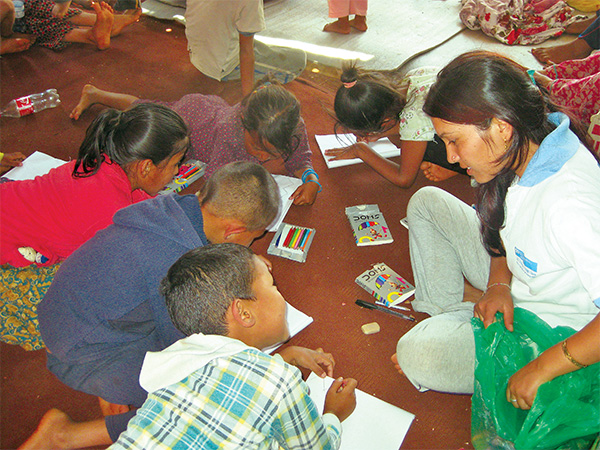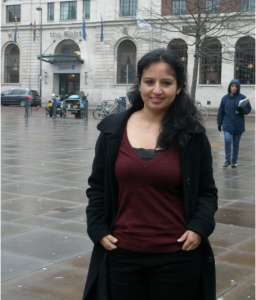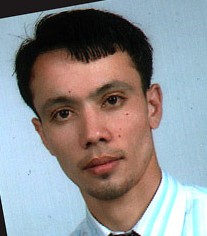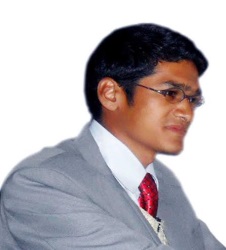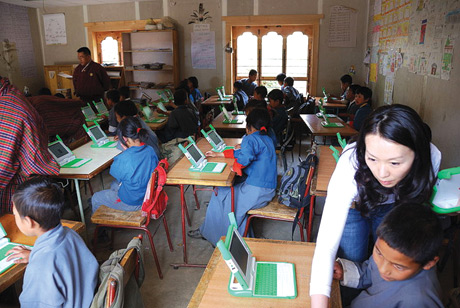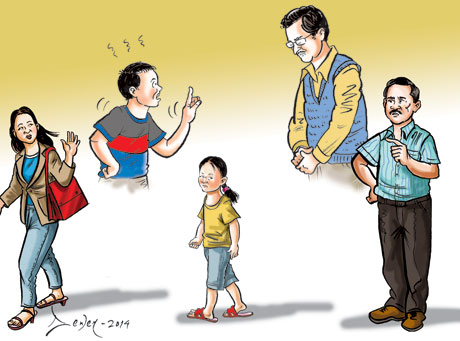
Reminiscing the day!
A large circle of Early Childhood Development (ECD) teachers–mostly female teachers–are joining their hands. Two facilitators in the hall, one inside the circle and the other at the corner, are observing the activity. Saturday, after the morning meal of 12th Baishakh 2072 (April 25, 2015), the second teacher training session of the day was in progress. The teachers were preparing for an introductory language game which requires them to perform a chant by clapping hands. Sometimes they needed to walk back and forth. Everybody was engrossed in how to perform game the best; they were excited with the easy tips and activities to teach the ECD kids in a better way. They were attending to every bit of the sound, the rhythm and the art of performing a circle-time activity in ECD classes. Then the facilitator in the center began instructing the participants for the refined repetition of the activity. When the participants had just started moving in the circle, the entire building trembled, and the whole earth shook so badly. Nobody could stand upright. Everybody started stumbling to the main gate of the hall. Earthquake! Earthquake! They cried. Soon, a pool of people from all around the vicinity arrived at the open ground in front of the hall, gasping up and trembling. They were praying for safety, for themselves, for their relatives and for their houses and property. In a minute, the exuberance of the training was converted into a formidable catastrophe and a deep serenity resided compelling people to give up all their arts and skills for the sake of life and bodily safety. It was indeed a mega earthquake disaster that had wiped out all the beautiful dreams instantly. Everybody attempted desperately to connect to their families; the entire atmosphere was then terror- driven by an unimagined might of the mother earth. In a minute, news reports about the fall of the Dharahara and many other heritage places were broadcast. TVs showed the damage of lives and buildings; soon, the whole country was mourning in the loss of dearest ones. Hospitals were crumbled, and there was a crowd of the injured outside hospitals. Scores of schools that cheered with the aspirations of the millions of future citizens were damaged; several public and private structures were flattened onto the ground. In a minute, most of the central part of Nepal was deserted. The Kathmandu valley lost several world heritages; the beautiful tourist destinations in Gorkha and the business hubs in Tatopani were completely damaged. People feared the most what they long forever- the hard earned resident buildings. Indeed there was a complete standstill of normal activities. This terror continued for over a month; it still haunts all those who were directly and indirectly affected. The country is thus under a dreadful situation hardest-hit by the earthquake.
Disaster situation in Nepal
Nepal is one of the most disaster prone countries in the world. Some of the disasters such as floods, landslides, cold waves, fire, and lightings are a common occurrence in Nepal. Every year, Nepalis are facing the problem of flood, landslide and fire particularly in the hot and summer season. It is reported that Nepal stands at the 11th and 30th position in terms of earthquake and water induced disasters respectively in the world. The vulnerability to disaster also continues to increase annually, particularly as a result of rapid population growth together with the unplanned and poorly regulated urban planning. The people of Nepal face a variety of life-threatening hazards. The recent earthquake of 7.8 magnitude and thousands of aftershocks have caused an insurmountable devastation in different parts of the country. Although the actual data about the human casualty and injuries and physical and economic damages are yet to be confirmed, the Ministry of Home Affairs has declared over 8500 casualties, and about 21,000 human injuries. The government has declared 11 districts as the most afflicted areas in terms of human and non- human damages. Informal observations and inquiries suggest that hundreds of human settlements (including houses and property) have been completely or partially destroyed. The roads, water supplies and electricity have been interrupted. Basic service centers such as schools and health centers and police posts have been dismantled. In a sense, a vast segment of population in the earthquake hit regions is living in a complete middle-aged-like-darkness at present.
Sample statistics about the impact of the disaster
Immediately after the devastating earthquake, the entire nation and several international organizations began their rescue and relief operations in Nepal. The government, charities and donors from different parts of the world joined hands to immediately help Nepal and its people to recover from the devastation. Inspired with the spirit of humanitarian assistance, I also worked with a non-governmental organization (Friends Service Council Nepal) in order to support the earthquake survivors in Lalitpur and Bhaktapur districts. We reached out to different earthquake affected communities with relief materials on the third of April 25 disaster. We were also accompanied by a team of volunteers that attempted to document human casualties and physical property in eight different communities. Among the 2900 supported families, 1192 were involved for a detailed survey. The survey shows a preliminary picture of the earthquake damage as follows.
| Figure 1: Respondent’s VDC/Municiplity | |||||
| Frequency | Percent | Valid Percent | Cumulative Percent | ||
| Valid | Jharuwarasi Lalitpur | 182 | 15.3 | 15.3 | 15.3 |
| Bishankhu Lalitpur | 92 | 7.7 | 7.7 | 23.0 | |
| Ikudol Lallitpur | 121 | 10.2 | 10.2 | 33.1 | |
| Shankhu Lalitpur | 191 | 16.0 | 16.0 | 49.2 | |
| Chapagaun Lalitpur | 71 | 6.0 | 6.0 | 55.1 | |
| Lamatar Lalitpur | 141 | 11.8 | 11.8 | 66.9 | |
| Dalchoki Lalitpur | 129 | 10.8 | 10.8 | 77.8 | |
| Maha Manjushree Bhaktapur | 265 | 22.2 | 22.2 | 100.0 | |
| Total | 1192 | 100.0 | 100.0 | ||
The sample communities have different characteristics in terms of the topography and development features. Two villages, Ikudol and Shankhu in Lalitpur, are located in a remote hilly area whereas Bishankhunarayan and Jharuwarashi are semi-urban settlements, near the city. Likewise, Chapagaun represents the community of the marginalized people (Dalit community) whereas Lamatar and Mahamanhusree represent to an averagely developed communities. These communities are chosen as to understand how the disaster acts upon differently built-up communities, though it has affected all Nepalis. The following table shows the present status of the respondents.
| Figure 2: Respondent’s present shelter status | |||||
| Frequency | Percent | Valid Percent | Cumulative Percent | ||
| Valid | Living under open sky | 413 | 34.6 | 34.6 | 34.6 |
| Living in tents outside | 666 | 55.9 | 55.9 | 90.5 | |
| Living in community places | 32 | 2.7 | 2.7 | 93.2 | |
| Living on rented homes | 41 | 3.4 | 3.4 | 96.6 | |
| Living in own home | 40 | 3.4 | 3.4 | 100.0 | |
| Total | 1192 | 100.0 | 100.0 | ||
Home is the source of aspiration and physical-emotional wellbeing for human beings. When there is a threat to our home, all the hopes turn into a painful agony and frustrations. A home is the emblem of emotional attachment; it doesn’t matter whether it is a cemented or just a thatched one. Education, prosperity and futurity become mere dreams when there is an instant threat to survival. We cannot even imagine how dreadful it is to live under the open sky. It was not an adventure for them; they were compelled by the unlucky fate. It was found that more than 90 percent of the sampled families had their houses either completely damaged or unfit for living. I cannot describe the pathetic situation of the children and the elderly. It is hard to describe the shattered dreams of the adults and how the damaged souls take on for the future. Buildings can be reconstructed, but it is very difficult to regain the shattered emotions and passion attached to them. The chart below displays the condition of damage houses and property in the sampled communities.
Figure 3: Damage of house and indoor property
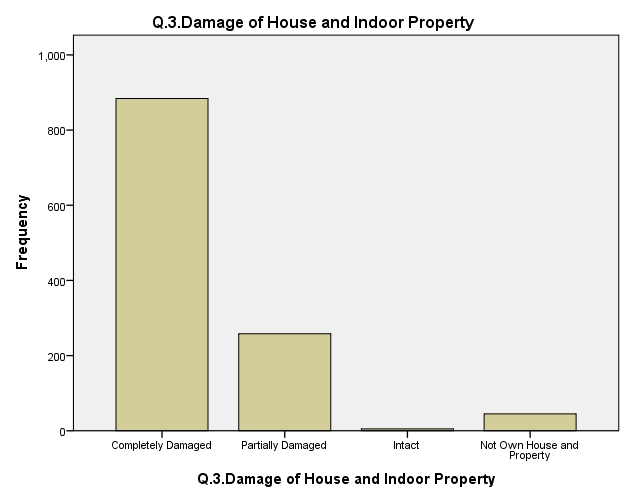
Along with private property, the earthquake also caused an insurmountable damage to the hard made public property. Local school is just an example. The Nepali society has a very short history of public education. Indeed, school represents the single most development indicator in many rural parts of the country. As of now, there are many places where no market places or health centers are built yet, but there are public schools to educate the children who could contribute to the national development in the future. Public schools are the only places that show the presence of the government and serve the poor and the disadvantaged. In the sampled communities the public school buildings are also flattened down; the children of these schools cannot takes classes in the past buildings. The new academic session had just started when their schools were crumbled. Reconstruction of these public school buildings is really a challenging work in the present context of Nepal, in which the private educational establishments are seemingly drawing the sympathy of the middle and upper classes of the society. These already peripheralized public schools may take a decade for their complete reconstruction. By then, millions of children might have been passing their formative lives yearning for a good school building. The condition of local public schools is presented below.
Figure 4: Damage of local public school

The post- disaster context in education
It is often observed that the emergency response to disasters such as flooding and earthquake focuses mostly on food, shelter, and water. Restoring the dignity and identity of the people become a less priority in the time of crisis. Education, which comes only after the survival needs is, therefore, affected for a longer time in the disaster-hit contexts. The relief and reconstruction initiatives in the present context of Nepal also observe a similar trend. Schools in the most disaster-affected areas had remained closed for over a month. During this long span of terror, a lot of upheavals could be seen in the everyday lives of the people. The quake took away the lives of 64 teachers and over 1,000 students and damaged 25 thousands classrooms. The entire community of teachers and students were also at a complete break-off from the teaching-learning activities. This situation shows an educational crisis in Nepal.
Even after the resumption of schools, a deep sense of fear lingered due to incessant aftershocks occurring day and night. The safe schools buildings had cracks due to aftershocks. A sense of terror was further exacerbated by the danger signals that hung at the entrance of the damaged buildings. Only a few schools had buildings which were safe educational activities. In such a situation, panic stricken teachers and students came to the school ground and involved mostly in psycho-socio trauma soothing activities. The reopening of schools created a space where teachers-students can get rid of the long held trauma. The trauma in the tender minds had to be released through non-content engagement rather than through involvement in instructional activities.
The deeper impacts of the disaster
The field of English language education in Nepal’s post-earthquake context is also no more appalling than other sectors. The primary indicator for this can be traced back to the psychological fear that has been lingering in the minds of students, teachers, parents and the general public. It is indeed a survival threat; a challenge to livelihood and safety of property. Be the cause the loss of relatives or acquaintances; be it the damage of houses and property, all the stakeholders of education, including the forefront agents (students, teachers and parents) are reeling the disaster with a terror and anguish. Neuropsychologists have researched in depth into how the differently specialized functions located in the different parts of the brain are affected by the survival threat of the organism; especially in relation to the role of Amygdala in the temporal lobes of the brain. It is, however, apt to note here that where there are fear and stress intrusions overpowering the normal functioning of the brain, there will hardly be any learning taking place. The brain is then sensitive to respond only against the threat to the ‘life’; it is focused to the ‘here and now’. The brain then spends most of its directional resources only to accumulate the energy spread across the body so that the collected energy can be used to save the life. This safety mechanism, so, responds in such behavioral forms as running away of the life-organism from the spot, sweating, uncontrolled urination, clenching of fists and teeth, and so on. We can argue that this is the state of a complete ‘distraction’ and ‘firewall’ of the normal academic practices required for learning, including English language learning. This phenomenon is similar to what Krashen argues in his Monitor Model of language acquisition (1977, 1988). In the context of disaster induced anxiety and fear, the monitor is already heightened (though not necessarily for filtering for the correctness) barring any perception and processing of the language input.
Another area of impact lies on the learners’ external social-material dimensions of education. It is evident that hundreds of school buildings have collapsed and become inhabitable for teaching-learning activities. All the classrooms, ‘facilities’, and ‘affordances’ are gone. The cosmic gloom that grows while observing the damaged school infrastructures can never be substituted with any other tragic feelings. But with better hopes some ‘Temporary Learning Centers’ have been built to help students engage in educational activities. Teachers are worrying about how long this situation persists. There is not a staff room intact. With this mega-scale disaster, people throughout the country have a very slim optimism for the speedy resettlement of the school facilities. Not only students have their textbooks and other stationeries buried or lost, but they have also lost the educative-entertaining community of hope in the pre-disaster days. Informal talks now are confined mostly to ‘where and of what scale of magnitude of the after- shocks’, and people are primarily concerned with ‘how to get relief materials. However, much attention has not been paid to reconstruction of schools and support to children. Indeed, the school atmosphere created the feeling of ‘unbelievable loss’ of the gambler, who cannot easily accept that the wallet has become completely empty just because of the single unlucky event. Every activity, and of course, everything in school and at home are strange now; there are strange classrooms and toilets; there are strange needs and responses of the students and the teachers. Occasional visits of the authorities and relief material providers further constrict the already shattered ego to the level of a pitiable infant-dependent. That the classrooms are damaged; that the library is collapsed; that the laboratory equipments are damaged; and that other basic school supplies are halted imply that school is shrinking down rather than flourishing. Therefore, the days ahead are going to be more challenging for EFL teachers to create conducive learning environment for the earthquake affected children. Again, when there is a threat to one’s livelihood, education and its quality, and a quality learning of English will surely be negatively affected.
—-
Mr. Dinesh Kumar Thapa, a life member of NELTA, is currently a Faculty of English at Kitini College Lalitpur Nepal. He has been teaching English at different levels for over 10 years. He is also involved in EL teacher training. He has published on issues related to ELT in different local and national journals. He is one of the editors of NELTA ELT Forum (neltaeltforum.wordpress.com).


